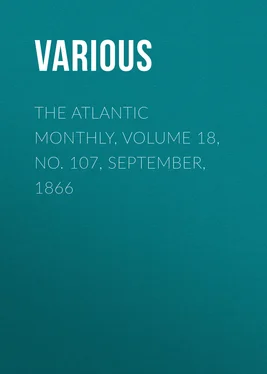Various - The Atlantic Monthly, Volume 18, No. 107, September, 1866
Здесь есть возможность читать онлайн «Various - The Atlantic Monthly, Volume 18, No. 107, September, 1866» — ознакомительный отрывок электронной книги совершенно бесплатно, а после прочтения отрывка купить полную версию. В некоторых случаях можно слушать аудио, скачать через торрент в формате fb2 и присутствует краткое содержание. Жанр: foreign_antique, periodic, foreign_edu, на английском языке. Описание произведения, (предисловие) а так же отзывы посетителей доступны на портале библиотеки ЛибКат.
- Название:The Atlantic Monthly, Volume 18, No. 107, September, 1866
- Автор:
- Жанр:
- Год:неизвестен
- ISBN:нет данных
- Рейтинг книги:4 / 5. Голосов: 1
-
Избранное:Добавить в избранное
- Отзывы:
-
Ваша оценка:
- 80
- 1
- 2
- 3
- 4
- 5
The Atlantic Monthly, Volume 18, No. 107, September, 1866: краткое содержание, описание и аннотация
Предлагаем к чтению аннотацию, описание, краткое содержание или предисловие (зависит от того, что написал сам автор книги «The Atlantic Monthly, Volume 18, No. 107, September, 1866»). Если вы не нашли необходимую информацию о книге — напишите в комментариях, мы постараемся отыскать её.
The Atlantic Monthly, Volume 18, No. 107, September, 1866 — читать онлайн ознакомительный отрывок
Ниже представлен текст книги, разбитый по страницам. Система сохранения места последней прочитанной страницы, позволяет с удобством читать онлайн бесплатно книгу «The Atlantic Monthly, Volume 18, No. 107, September, 1866», без необходимости каждый раз заново искать на чём Вы остановились. Поставьте закладку, и сможете в любой момент перейти на страницу, на которой закончили чтение.
Интервал:
Закладка:
Not only were the appointments of the warriors adorned by needle-work, but the ladies must have found ample scope for industry and taste in their own toilets. The Anglo-Saxon women as far back as the eighth century excelled in needle-work, although, judging from the representations which have come down to us, their dress was much less ornamented than that of the gentlemen. During the eighth, ninth, and tenth centuries there were few changes in fashion. A purple gown or robe, with long yellow sleeves, and coverchief wrapt round the head and neck, frequently appears, the edges of the long gown and sleeves being slightly ornamented by the needle. How the ladies dressed their hair in those days is more difficult to decide, as the coverchief conceals it. Crisping-needles to curl and plat the hair, and golden hair-cauls, are mentioned in Saxon writings, and give us reason to suppose that the locks of the fair damsels were not neglected. In the eleventh century the embroidery upon the long gowns becomes more elaborate, and other changes of the mode appear.
From the report of an ancient Spanish ballad, the art of needle-work and taste in dress must have attained great perfection in that country while our Anglo-Saxon sisters were wearing their plain long gowns. The fair Sybilla is described as changing her dress seven times in one evening, on the arrival of that successful and victorious knight, Prince Baldwin. First, she dazzles him in blue and silver, with a rich turban; then appears in purple satin, fringed and looped with gold, with white feathers in her hair; next, in green silk and emeralds; anon, in pale straw-color, with a tuft of flowers; next, in pink and silver, with varied plumes, white, carnation, and blue; then, in brown, with a splendid crescent. As the fortunate Prince beholds each transformation, he is bewildered (as well he may be) to choose which array becomes her best; but when
"Lastly in white she comes, and loosely
Down in ringlets floats her hair,
'O,' exclaimed the Prince, 'what beauty!
Ne'er was princess half so fair.'"
Simplicity and natural grace carried the day after all, as they generally do with men of true taste. "Woman is fine for her own satisfaction alone," says that nice observer of human nature, Jane Austen. "Man only knows man's insensibility to a new gown." We hope, however, that the dressmakers and tirewomen of the fair Sybilla, who had expended so much time and invention, were handsomely rewarded by the Prince, since they must have been most accomplished needle-women and handmaids to have got up their young lady in so many costumes and in such rapid succession.
A very odd fashion appears in the thirteenth and fourteenth centuries, of embroidering heraldic devices on the long gowns of the ladies of rank. In one of the illuminations of a famous psalter, executed for Sir Geoffery Loutterell, who died in 1345, that nobleman is represented armed at all points, receiving from the ladies of his family his tilting helmet, shield, and pavon . His coat of arms is repeated on every part of his own dress, and is embroidered on that of his wife, who wears also the crest of her own family.
Marie de Hainault, wife of the first Duke of Bourbon, 1354, appears in a corsage and train of ermine, with a very fierce-looking lion rampant embroidered twice on her long gown. Her jewels are magnificent. Anne, Dauphine d'Auvergne, wife of Louis, second Duke of Bourbon, married in 1371, displays an heraldic dolphin of very sinister aspect upon one side of her corsage, and on the skirt of her long gown,—which, divided in the centre, seems to be composed of two different stuffs, that opposite to the dolphin being powdered with fleurs de lis . Her circlet of jewels is very elegant, and is worn just above her brow, while the hair is braided close to the face. An attendant lady wears neither train nor jewels, but her dress is likewise formed of different material, divided like that of the Dauphine. Six little parrots are emblazoned on the right side, one on her sleeve, two on her corsage, and three on her skirt. The fashion of embroidering armorial bearings on ladies' dresses must have given needle-women a vast deal of work. It died out in the fifteenth century.
It was the custom in feudal times for knightly families to send their daughters to the castles of their suzerain lords, to be trained to weave and embroider. The young ladies on their return home instructed the more intelligent of their female servants in these arts. Ladies of rank in all countries prided themselves upon the number of these attendants, and were in the habit of passing the morning surrounded by their workwomen, singing the chansons à toile , as ballads composed for these hours were called.
Estienne Jodelle, a French poet, 1573, addressed a fair lady whose cunning fingers plied the needle in words thus translated:—
"I saw thee weave a web with care,
Where at thy touch fresh roses grew,
And marvelled they were formed so fair,
And that thy heart such nature knew.
Alas! how idle my surprise,
Since naught so plain can be:
Thy cheek their richest hue supplies,
And in thy breath their perfume lies;
Their grace and beauty all are drawn from thee."
If needle-work had its poetry, it had also its reckonings. Old account-books bear many entries of heavy payments for working materials used by industrious queens and indefatigable ladies of rank. Good authorities state that, before the sixth century, all silk materials were brought to Europe by the Seres, ancestors of the ancient Bokharians, whence it derived its name of Serica. In 551, silk-worms were introduced by two monks into Constantinople, but the Greeks monopolized the manufacture until 1130, when Roger, king of Sicily, returning from a crusade, collected some Greek manufacturers, and established them at Palermo, whence the trade was disseminated over Italy.
In the thirteenth century, Bruges was the great mart for silk. The stuffs then known were velvet, satin (called samite), and taffeta,—all of which were stitched with gold or silver thread. The expense of working materials was therefore very great, and royal ladies condescended to superintend sewing-schools.
Editha, consort of Edward the Confessor, was a highly accomplished lady, who sometimes intercepted the master of Westminster School and his scholars in their walks, questioning them in Latin. She was also skilled in all feminine works, embroidering the robes of her royal husband with her own hands.
Of all the fair ones, however, who have wrought for the service of a king, since the manufacture of Excalibur, let the name of Matilda of Flanders, wife of William the Conqueror, stand at the head of the record, in spite of historians' doubts. Matilda, born about the year 1031, was carefully educated. She had beauty, learning, industry; and the Bayeux tapestry connected with her name still exists, a monument of her achievements in the art of needle-work. It is, as everybody knows, a pictured chronicle of the conquest of England,—a wife's tribute to the glory of her husband.
As a specimen of ancient stitchery and feminine industry, this work is extremely curious. The tapestry is two hundred and twenty-two feet in length and twenty in width. It is worked in different-colored worsteds on white cloth, now brown with age. The attempts to represent the human figure are very rude, and it is merely given in outline. Matilda evidently had very few colors at her disposal, as the horses are depicted of any hue,—blue, green, or yellow; the arabesque patterns introduced are rich and varied.
During the French Revolution, this tapestry was demanded by the insurgents to cover their guns; but a priest succeeded in concealing it until the storm had passed. Bonaparte knew its value. He caused it to be brought to Paris and displayed, after which he restored the precious relic to Bayeux.
Читать дальшеИнтервал:
Закладка:
Похожие книги на «The Atlantic Monthly, Volume 18, No. 107, September, 1866»
Представляем Вашему вниманию похожие книги на «The Atlantic Monthly, Volume 18, No. 107, September, 1866» списком для выбора. Мы отобрали схожую по названию и смыслу литературу в надежде предоставить читателям больше вариантов отыскать новые, интересные, ещё непрочитанные произведения.
Обсуждение, отзывы о книге «The Atlantic Monthly, Volume 18, No. 107, September, 1866» и просто собственные мнения читателей. Оставьте ваши комментарии, напишите, что Вы думаете о произведении, его смысле или главных героях. Укажите что конкретно понравилось, а что нет, и почему Вы так считаете.












